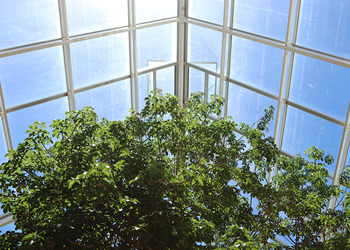
Biophilic Windows: Connecting Buildings with Nature for Enhanced Well-being
Introduction
In an increasingly urbanized world, where people spend most of their time indoors, the need to create environments that foster a connection with nature has never been greater. Biophilic design, an approach that integrates elements of nature into built spaces, offers a solution. In this blog, we explore the concept of biophilic windows designed to bring nature closer to building occupants. Biophilic windows incorporate natural materials, greenery, and views of the outdoor environment, promoting well-being, productivity, and a sense of harmony. Discover the benefits and potential applications of biophilic windows in enhancing our relationship with nature in the built environment.
Bringing Nature Indoors: Biophilic Design
The biophilic design recognizes the inherent human need to connect with nature. It aims to create spaces that mimic the natural world, promoting physical and psychological well-being. One key element of biophilic design is the integration of windows that go beyond providing light and view, but actively enhance the connection with nature.
Biophilic Windows: Elements and Features
Biophilic windows are specifically designed to incorporate natural elements and create a seamless connection with nature. Here are some elements commonly found in biophilic windows:
Natural Materials
Biophilic windows utilize natural materials like wood frames, stone sills, or bamboo shades. These materials bring a tactile and organic quality to the window, evoking a sense of grounding and harmony.
Greenery:
Incorporating living plants near or within the window frame adds a touch of nature inside. Hanging planters, green walls, or window boxes can introduce the calming presence of foliage, purify the air, and soften the built environment.
Views of Nature
Optimizing views of outdoor landscapes or green spaces is a fundamental aspect of biophilic windows. Large windows, panoramic views, or strategically placed openings provide occupants with glimpses of nature, fostering a sense of connection even while indoors.
Natural Light
Biophilic windows maximize the ingress of natural daylight, reducing the need for artificial lighting and creating a harmonious ambiance. Well-designed windows allow ample natural light to enter, creating a dynamic interplay between light and shadow that mimics natural patterns.
Benefits of Biophilic Windows
The incorporation of biophilic windows offers a myriad of benefits to building occupants and the overall environment:
Enhanced Well-being
Exposure to nature, even through windows, has been shown to reduce stress levels, improve mood, and enhance overall well-being. Biophilic windows create a visual connection with the outdoors, allowing occupants to experience the calming effects of nature and resulting in increased productivity and reduced fatigue.
Improved Cognitive Function
Studies have indicated that views of nature, natural light, and greenery have a positive impact on cognitive function, concentration, and creativity. Biophilic windows provide access to these elements, supporting mental clarity and improving performance in various tasks.
Biophilic Window Therapy
Biophilic windows can be particularly beneficial in healthcare settings. Patients with views of nature experience faster recovery times, reduced pain perception, and improved emotional well-being. Biophilic window therapy has also shown positive impacts on attention restoration and stress reduction in educational and work environments.
Sustainable Design
Biophilic windows align with sustainable design principles by maximizing the use of natural light, reducing the need for artificial lighting, and improving energy efficiency. They can contribute to green building certifications and help reduce the carbon footprint of buildings.
Drawbacks of Biophilic Window
While biophilic windows offer numerous benefits, they may also present a few challenges. Let’s examine some potential problems associated with biophilic windows and discuss possible solutions to tackle them:
Maintenance and Care:
Problem: Biophilic windows that incorporate live plants or greenery require regular maintenance, including watering, pruning, and monitoring plant health. Neglecting these tasks can lead to the deterioration of the plants and create an unpleasant visual impact.
Solution: Implement a proper maintenance plan that includes regular watering, fertilizing, and pruning of the plants. Assign responsible individuals or hire professional services to ensure the upkeep of the greenery in the windows. Automated irrigation systems or self-watering planters can also be considered to simplify the maintenance process.
Solar Heat Gain:
Problem: Large windows, especially those with expansive views, may result in increased solar heat gain, leading to discomfort and increased cooling needs. This can impact energy efficiency and occupant comfort.
Solution: Employ energy-efficient glazing technologies, such as Low-E coatings, spectrally selective glazing, or insulated panels, to mitigate solar heat gain. These technologies help to reduce the amount of infrared radiation that enters the building while still allowing natural light to pass through. External shading devices like louvers or blinds can also be utilized to control the amount of sunlight entering the space.
Glare and Visual Comfort:
Problem: Uncontrolled sunlight entering through biophilic windows can cause glare issues, impairing visual comfort and making it difficult to use electronic displays or perform tasks that require high visual acuity.
Solution: Consider integrating adjustable shading elements such as roller blinds, curtains, or automated tinting systems that can be adjusted to control the amount of incoming light and reduce glare. These shading systems should be easily operable by occupants to ensure individual preferences and comfort.
Privacy Concerns:
Problem: With biophilic windows providing expansive views of the outdoors, privacy concerns may arise, especially in densely populated areas or spaces where privacy is essential.
Solution: Incorporate window treatments like frosted or translucent films, adjustable blinds, or smart glass that can be electronically controlled to change opacity. These solutions allow occupants to maintain privacy as needed while still allowing access to natural light and views when desired.
- Structural Considerations:
Problem: The introduction of biophilic windows with additional elements like greenery or heavier framing materials can impact the structural integrity of window systems and may require modifications to support the added weight or accommodate the design changes.
Solution: Collaborate with architects, structural engineers, and window system manufacturers to ensure that the building’s structural integrity can accommodate the design specifications of biophilic windows. Structural assessments and calculations should be conducted to determine if any reinforcements or modifications are necessary.
Conclusion:
While biophilic windows offer numerous benefits, addressing potential problems is crucial to maximizing their effectiveness and ensuring occupant satisfaction. By implementing appropriate maintenance practices, employing energy-efficient glazing and shading technologies, managing glare and privacy concerns, and considering structural implications, the challenges associated with biophilic windows can be effectively tackled. With proper planning and implementation, biophilic windows can continue to offer a seamless connection with nature while addressing potential drawbacks for a truly harmonious indoor environment.
Applications and Design Considerations
The potential applications of biophilic windows are diverse, ranging from residential to commercial and public spaces. Here are a few examples:
Residential Spaces
Biophilic windows can transform homes into havens of tranquility and connection with nature. Floor-to-ceiling windows that frame natural vistas, skylights for stargazing, or indoor gardens incorporated into window sills can create immersive experiences.
Workspaces
Incorporating biophilic windows in offices and workplaces can boost employee well-being, reduce stress, and increase productivity. Views of green spaces, natural light, and living walls contribute to a healthier and more enjoyable work environment.
Educational Institutions
Biophilic windows in schools and universities create environments that enhance concentration, creativity, and student well-being. Natural light and views of nature positively influence learning outcomes, fostering a more engaging educational experience.
Healthcare Facilities
Hospitals and healthcare centers can benefit from biophilic windows that provide patients, staff, and visitors with views of healing landscapes and gardens. Incorporating plants, water features, and natural light can create a calming and restorative environment.
When incorporating biophilic windows, several design considerations should be taken into account. These include optimizing window placement for maximum views, balancing natural light with glare control, using sustainable materials, and ensuring proper maintenance of living plant features.
Conclusion
Biophilic windows have the potential to transform the indoor environment, bringing the soothing presence of nature closer to building occupants. By incorporating natural materials, greenery, and views of the outdoor environment, these windows foster a sense of well-being, productivity, and harmony. As biophilic design gains recognition as a key aspect of sustainable architecture, biophilic windows become an essential element in forging a deeper connection with nature within the built environment. Embracing biophilic design principles and integrating these windows into residential, commercial, and educational spaces holds the promise of creating healthier, more sustainable, and inspiring environments.
references :
- https://sheararchitecturaldesign.co.uk/the-impact-of-biophilic-design-on-health-and-well-being-in-modern-homes/
- https://thermory.com/blog-and-news/the-six-elements-of-biophilic-design/


